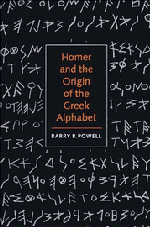Book contents
- Frontmatter
- Contents
- List of figures
- List of tables
- Acknowledgements
- Abbreviations
- A note on terms and phonetic transcriptions
- Chronological charts
- Maps
- Foreword: Why was the Greek alphabet invented?
- 1 Review of criticism: What we know about the origin Greek alphabet
- 2 Argument from the history of writing: How writing worked before the Greek alphabet
- 3 Argument from the material remains: Greek inscriptions from the beginning to c. 650 b.c.
- 4 Argument from coincidence: Dating Greece's earliest poet
- 5 Conclusions from probability: how the Iliad and Odyssey were written down
- APPENDIX I Gelb's theory of the syllabic nature of West Semitic writing
- APPENDIX II Homeric references in poets of the seventh century
- Definitions
- Bibliography
- Index
2 - Argument from the history of writing: How writing worked before the Greek alphabet
Published online by Cambridge University Press: 01 June 2011
- Frontmatter
- Contents
- List of figures
- List of tables
- Acknowledgements
- Abbreviations
- A note on terms and phonetic transcriptions
- Chronological charts
- Maps
- Foreword: Why was the Greek alphabet invented?
- 1 Review of criticism: What we know about the origin Greek alphabet
- 2 Argument from the history of writing: How writing worked before the Greek alphabet
- 3 Argument from the material remains: Greek inscriptions from the beginning to c. 650 b.c.
- 4 Argument from coincidence: Dating Greece's earliest poet
- 5 Conclusions from probability: how the Iliad and Odyssey were written down
- APPENDIX I Gelb's theory of the syllabic nature of West Semitic writing
- APPENDIX II Homeric references in poets of the seventh century
- Definitions
- Bibliography
- Index
Summary
Although problems of outer form should not be neglected in a treatise on writing, I personally am inclined toward a reconstruction of the history of writing based more on the inner characteristics.
(I. J. Gelb)Being ourselves the users of a writing which structurally is the Greek alphabet, we are at a disadvantage working backward in time toward the moment of the alphabet's invention. For we carry an expectation about the way writing is bound to work that makes it hard for us to see what sort of innovation the Greek alphabet was. We will need to turn our attention to the structure of writing systems in general, if we wish to place the invention of the alphabet in context in the history of writing. It will be necessary to assess, however briefly, the history of writing before the Greek alphabet, and to examine in some detail, using a consistent terminology, the actual functioning of early writing systems. Let us choose three specimens of early writing, for the purpose of our analysis: (1) Egyptian hieroglyphics, usually thought to be the oldest ancestor of the Greek alphabet; (2) the Cypriote syllabary, a prealphabetic writing that recorded the Greek language; and (3) Phoenician, the alphabet's immediate predecessor. Important to our inquiry will no longer be shapes, names, and sounds, but how signs were used in combination, their syntax in transforming speech, fact, idea, into a physical record.
- Type
- Chapter
- Information
- Homer and the Origin of the Greek Alphabet , pp. 68 - 118Publisher: Cambridge University PressPrint publication year: 1991



